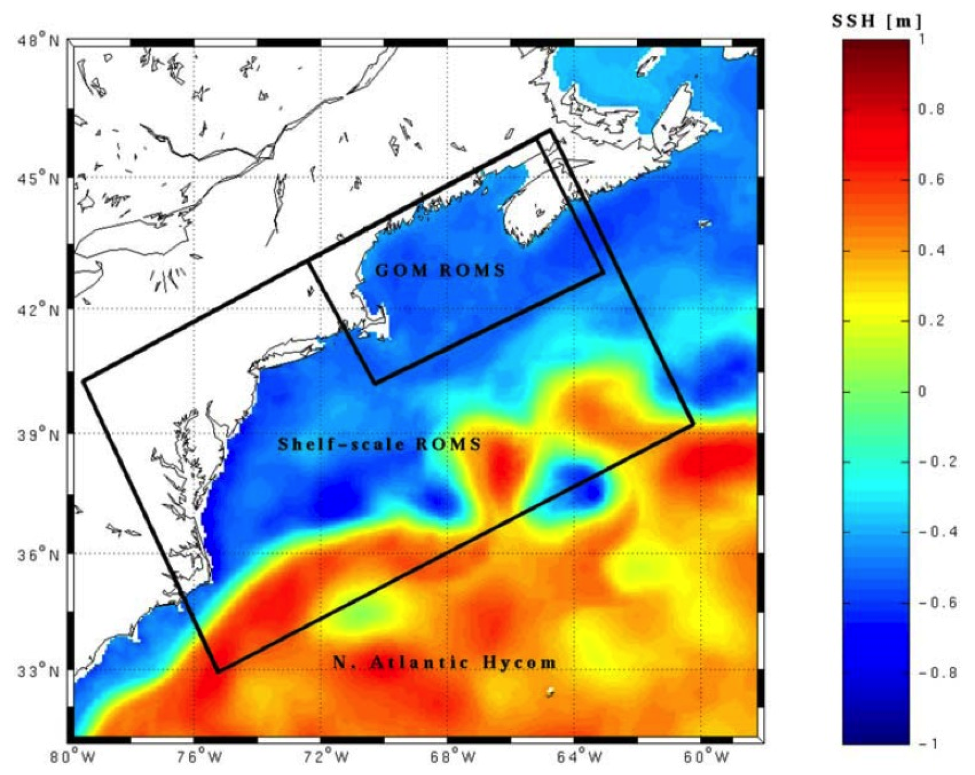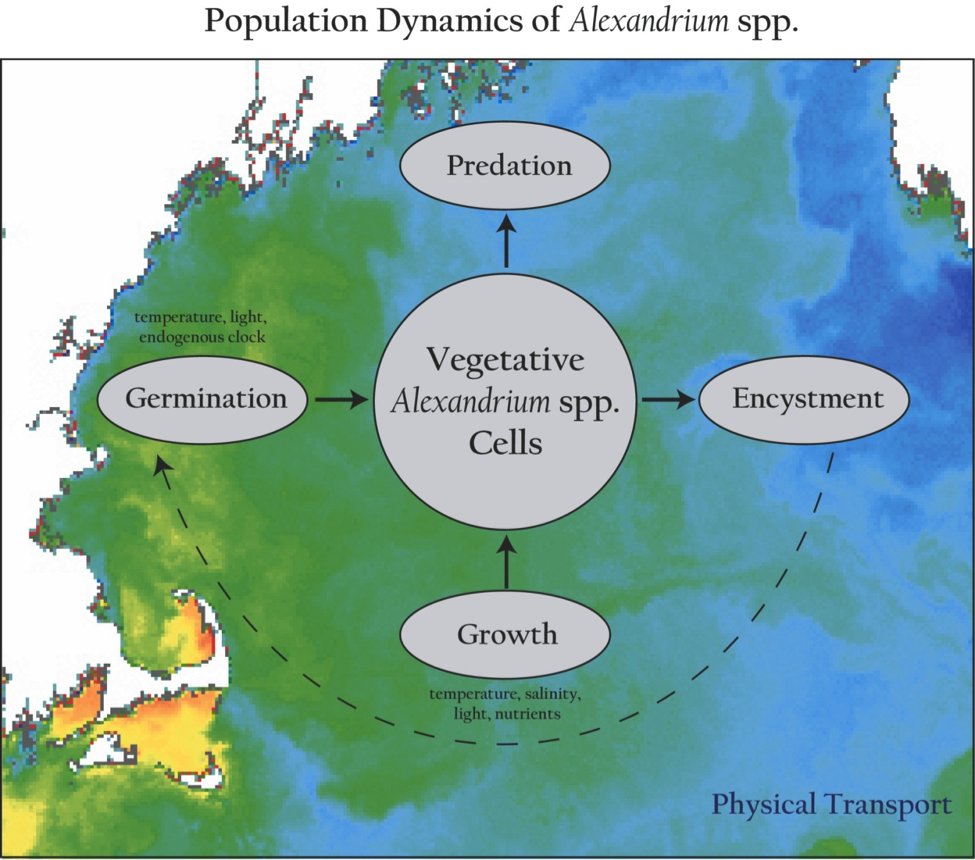Forecasting HABs in the Gulf of Maine
Computer models are used to predict the distribution and abundance of the toxic dinoflagellate Alexandrium catenella in the Gulf of Maine. These predictions take two forms: (1) a seasonal forecast issued prior to the bloom season, and (2) weekly updates that hindcast the bloom up to that date, and forecast bloom conditions for the coming week. Both systems utilize a high-resolution (1-3km in the horizontal, 36 vertical layers) model of the region, which is nested in a shelf-wide model spanning the waters from the Carolinas to Nova Scotia, which is in turn nested within a global operational model (See Figure 1). This multiply-nested configuration provides the spatial resolution necessary for this coastal application, making direct use of an operational model to provide the boundary conditions needed for regional domains.
The conceptual basis of the forecast system is that, all other things being equal, the abundance of A. catenella resting cysts is a first-order predictor of the magnitude of the bloom in the upcoming year. In a sense, this approach is analogous to techniques used for fisheries management—‘recruitment’ is measured in the autumn by quantifying the abundance of resting cysts, thereby facilitating an estimate of the ‘stock’ of A. catenella in the subsequent bloom season. The initial condition, starting March 1 of each year, is that the concentration of A. catenella motile (vegetative) cells is zero throughout the model domain. Cells enter the water column via germination, which is computed from the observed distribution of resting cysts and excystment rates based on laboratory measurements. The population grows as a function of light, temperature, salinity, and nutrient concentration, all of which are also constrained by experimental laboratory results. Cells are lost from the water column with a temperature-dependent mortality. All of this takes place in the complex three-dimensional hydrodynamic environment simulated by the model, which continually redistributes the population via transport and mixing (Figure 2).
In advance of each bloom season, a seasonal forecast is computed using the observed cyst abundance and a range of environmental conditions from preceding years. For example, in 2014 there were ten ensemble members, based on archived hydrodynamic hindcasts for each year, 2004-2013. The resulting ensemble forecast provides an estimate of the range of possible outcomes based on recent history, analogous to the “cone of uncertainty” in hurricane forecasting. Once the season begins, the forecast model is run weekly with forcing from that particular year, using seven-day forecast atmospheric and oceanic boundary conditions. In each subsequent cycle, the forecast forcing is replaced with “reanalysis” hindcasts, and updated forecast forcing is used for the coming week. This iterative process takes place for the entire bloom season, from March 1 through August 1. This system is currently operational within NOAA, and model simulated surface Alexandrium catenella in the Gulf of Maine region can be accessed here.
For the most recent descriptions of the forecast model see He et al. (2008), Li et al. (2009), and McGillicuddy et al. (2011). For cyst distributions, see Anderson et al. (2014).
Forecast results for 2006-2015 are available at: http://omgsrv1.meas.ncsu.edu/GoMaine_Redtide/
The Seasonal Forecast for 2021 is under development. Forecasts issued for prior years can be accessed here.


Figure 2. The A. fundyense population dynamics model. Fundamental to this approach is the concept that the ecosystem in which A. fundyense resides is not explicitly modeled. This is justified on the basis that, with very few exceptions, A. fundyense constitutes a small fraction of the total phytoplankton species assemblage in the GOM. As such, it does not materially affect either the ambient nutrient concentrations or predator abundances. Therefore these “ecosystem effects” can be parameterized through their influence on the vital rates of A. fundyense’s population dynamics. These vital rates are complex functions of environmental parameters, such as temperature, salinity, light and nutrients in the case of vegetative growth, and temperature, light and an endogenous clock in the case of germination. All of this takes place in an complex, turbulent, three-dimensional fluid medium, some characteristics of which are evident in the sea surface temperature image on which this schematic is overlaid. (Dennis McGillicuddy, WHOI)
